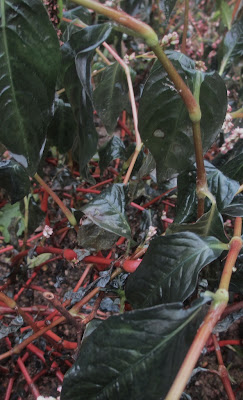Instead of regular class at the house on Tuesdays my students and I visited an antique dealer's house in Tokyo who had come to have several thousand old
katagami stencils for luxury kimono. The master craftsman who had owned and used them had passed away over 20 years ago and his children were cleaning up his old studio/ house to tear it down and sell the land.
Antique markets in Japan always have a few stalls selling rolls of these stencils for someone to purchase and use as an interior design object. Lampshades or perhaps to be framed. Very few people know how the stencils were actually used. We were there to purchase stencils we could use as well as glean ideas for stencils we could design and cut ourselves. Some were just so breathtaking in their complexity we bought them just to have and marvel at on a rainy day. This was an untouched intact, previously unpicked over jackpot of
katagami stencils.
Oh la la.
Uncomfortably rummaging, not only through someone's life but also through a nearly extinct and breathtaking kimono dyeing technique was both debilitating as well as invigorating. We were seriously burnt-out after a few hours of evaluating stencils as our eyes and criteria sharpened with each hundred leafed-through, while filling out our personal collections.
Many of the stencils came in bundles of 30. Wrap your head around this.... It would take 30 (or many more) individually hand-carved stencils, for each colour and to resist areas with rice-paste to dye the background colours. These were for
Edo Sarasa stencil technique kimono from the 1960's through to the late 80's when the craftsman had passed away.
A book could be written about the pile of stencils and sketches and cloth samples on the table beside me. It hasn't been written and I don't have the time to do it. Just a blog entry.
With some bundles of stencils were the hand drawn original sketches for the patterns that also acted as colour keys for the dyer to use. Here are a few I picked up. You can see the Indian and Arabic influences along with the pure Japanese stuff. These are the patterns that would be repeatedly dyed on 14 meters of silk with seamless accuracy. A thousand hours of work? More?
An individual stencil would be cut for each colour and a series of stencils cut to resist the pattern so that the background colour could be applied.
This leaf pattern stencil is easy to understand. Only three stencils instead of thirty. The paper is the smoked persimmon tannin layered paper that has been developed over hundreds of years to perfectly fit with these dyeing techniques.
Here is a small swatch of Edo Sarasa cloth.
I will write more about that day in the next few blogs. The ingenuity of the stencil designs and the how we will use some of our given-up-for-dead stencils. I would prefer for my students to design and carve our own original stencils but since we bought these we should respect them and use them a few times.





































